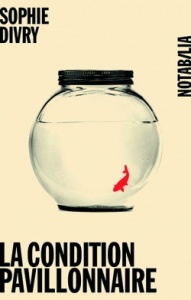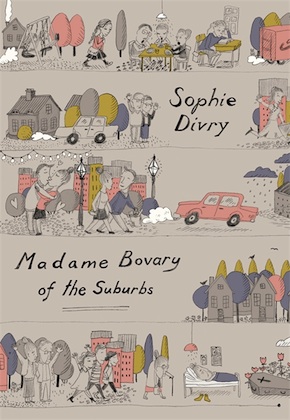Elegy in E minor
by Mika Provata-CarloneOf a summer in Spain, where she is vacationing as a university student, M.A. will mostly recall “the portraits of Franco; you thought that was just his first name and you were surprised everyone was on such familiar terms with a head of state.” It is this subtle blend of French phlegm, disingenuously simulated naiveté and the feeling that la vraie vie est ailleurs, that flows languidly, narcotically, through Sophie Divry’s Madame Bovary of the Suburbs.
M.A.’s story, as an acknowledged echo of all that is evoked by the very sound of those two initials, Em-ă in their French phonetic form, emerges as one of the narratives of collective female experience – of a certain milieu and historical moment, a particular psychosynthesis and possible world view. Also of a moment in the material history of time and society, a Polaroid of a very specific generation, one which made the transition between a historical and a metahistorical state of humanity.
As we follow the life and milestones of M.A. indulgently, languorously, inexorably, we become enveloped by a sense of rosy aurora borealis through which emotions, personalities, events and especially the thingness of reality are viewed, processed, glossed over, even when recalled as emptying rather than fulfilling elements of a life lived long. Reality, Divry seems to say, exists only in hindsight, not in the present, nor in daydreams about the future. There is a penetrating clarity of backward vision, where the ache of missed signals, opportunities, emotions, counterbalances the élan vital of individual life.
Madame Bovary of the Suburbs (the original title is La Condition pavillonnaire, or The Suburbia State of Being) is not a narrative in time but in the timelessness of memory, of an eternal return and recurrence of time. M.A. is not so much a narrator or the heroine of her story as she is a projected consciousness, an existence placed centre stage as the play of her life nears its final, terminal curtain. If the phrase “Madame Bovary c’est moi” became an explosive battle cry in the wake of Flaubert’s masterpiece, the pointing finger of “Madame Bovary is you” is explicitly Divry’s take on the monumental classic. Humorous and affectionate cameos of stereotypical male and female behaviour, the vanity and the fruitlessness of trivial quotidian gestures as cornerstones of a banal existence, the attitudes and accoutrements of an appropriate, appropriated life are given by Divry eschatological and existential connotations, as well as a floatiness, a permeability that renders them evocative and distinctly resonant without ever tainting them with facile irony or platitude.
There is a marbling effect between memory and existence, as the two become interlinked, welded, melding with rainbow-like diffusiveness.”
Memory is the key player and the arch-satirist here, decreeing a liquid, plasma-like continuity of succession, interchangeability, impersonality. There is a marbling effect between memory and existence, as the two become interlinked, welded, melding with rainbow-like diffusiveness. M.A.’s is a very tactile, visual memory, with things, objects, the material world and its physical, tangible, discardable underpinnings leading the way to concretising an otherwise suspended existence. Uniqueness and originality consist in being able to repeat the journeys, gestures, utterances and experiences that have always preceded and pre-existed one’s emergence into this world, as well as those that run a parallel course along one’s own ineffable distinctiveness. This is a fond exposure of atavism and of the small imperceptible breaks effecting ‘social advancement’, i.e. greater material comfort, modernity, physical visibility and standardising affirmation.
Madame Bovary of the Suburbs is in fact an anti-Emma Bovary, confronting contemporary or timeless Flaubertianism with the emotionally and experientially rich reality this seemingly mundane progeny possesses, albeit unbeknownst to her. Rather than a heroine breaking social moulds and class/gender rules, Madame Bovary, Divry seems to say, was as blind as she was vain, as empty as she was ambitious, as insignificantly predictable and ordinary as her tragedy was searing, extreme, shattering for her fictional self and for the very real society around her and beyond her. This deep-sea dive into memory reveals a resistance to the Flaubertian model, just as it confirms the incipient causes and motivations, the archetypal feelings and drives behind it: we see in M.A.’s life, the ‘events’ she so longingly awaits, a humanity full of frailness and blushing presumption, but also full of the strength of its bonds, attachments, the accruement of small, insignificant, yet vital trinket-treasures.
 Divry delivers an elegy to perfect bourgeois bliss that does not sound or feel ironic, does not need or include irony in its ontological construct. Even the gradual deterioration or rather dilution of relationships is part of that non-ironic perfect constellation of things, a delicate, if vulgaire, balance of habit. The motion of remembrance is palindromic, a palimpsest where distant and more recent past reflections intermingle in a prolonged, yet not unpleasing pageant of images, echoes, what-ifs and forever-nots. The voice extracting and resurfacing these fathom-nodes of life transcends its own measureable specificity and morphs into a narrative of the 20th and early 21st century – a memory-time capsule of the blurred historicity of post-WWII Western society for non-terrestrials, an inventory of human life for future non-human ethnographers that would follow eerily, scientifically, self-assuredly, on the tracks of a long forgotten Thor Heyerdahl. The narrative voice, which for all its ‘you’ inflections is never a j’accuse, visits each paving stone of M.A.’s long, predictable, steady journey as both observer and observed, from cars to the purchase of property, to careers and the raising of children, to social rituals such as holidays, relations, words, thoughts, codes of dress and behaviour. Deviation, violence, vice, poverty or misery are external, barely conceivable phenomena to this plenary tangential to reality and history, in this world where “the word problem would no longer exist.”
Divry delivers an elegy to perfect bourgeois bliss that does not sound or feel ironic, does not need or include irony in its ontological construct. Even the gradual deterioration or rather dilution of relationships is part of that non-ironic perfect constellation of things, a delicate, if vulgaire, balance of habit. The motion of remembrance is palindromic, a palimpsest where distant and more recent past reflections intermingle in a prolonged, yet not unpleasing pageant of images, echoes, what-ifs and forever-nots. The voice extracting and resurfacing these fathom-nodes of life transcends its own measureable specificity and morphs into a narrative of the 20th and early 21st century – a memory-time capsule of the blurred historicity of post-WWII Western society for non-terrestrials, an inventory of human life for future non-human ethnographers that would follow eerily, scientifically, self-assuredly, on the tracks of a long forgotten Thor Heyerdahl. The narrative voice, which for all its ‘you’ inflections is never a j’accuse, visits each paving stone of M.A.’s long, predictable, steady journey as both observer and observed, from cars to the purchase of property, to careers and the raising of children, to social rituals such as holidays, relations, words, thoughts, codes of dress and behaviour. Deviation, violence, vice, poverty or misery are external, barely conceivable phenomena to this plenary tangential to reality and history, in this world where “the word problem would no longer exist.”
Instead, M.A.’s life concentrates around anchoring insignificant events, yet without the shattering tension of Emma’s yearning, “in the very depths of her soul”, for “un événement.” Perhaps our post-historical society can no longer accommodate earthquakes of feeling, crisis and change? Following T.S. Eliot, perhaps Divry’s unspoken instinct is also echoed in Burnt Norton: “Go, go, go, said the bird: human kind / Cannot bear very much reality”. Page after page we are compelled to consider the clutter and compulsions, forced or voluntary, which we call the order of our lives, and Madame Bovary of the Suburbs certainly lives up to Flaubert’s own intentions of writing “un livre sur rien”, “a book about nothing at all” or “on nothingness”, as he wrote to Louise Colet. Divry possesses a vivid, well-calibrated descriptive gift, an inherent sense of the muchness of meiosis. She is a sharp judge of the juxtapositions between the moment and time, the event and life. “Everything will go on; won’t it” becomes the ouroboros refrain of the novel, the last phatic sentence suspending and fixing conclusions and endings.
Unlike Flaubert, Divry appears to have no nervous disposition, possessing instead a presence reminiscent of a delicate racehorse about to dash full ahead.”
Languidly and leisurely translated by Alison Anderson to suit Divry’s interiority, with perhaps some perplexing choices where the echoes of the French text become elusive in the efforts to create an English vernacular or where cultural references become enigmatically metamorphosed in the transition, this is a novel where novelty and tradition coincide. Divry has stated that she is against the nouveau roman and equally opposed to the reaction against tradition and convention for the sake of reaction alone. She is, she says, “in search of the formal side of literature” and the “art of writing”, “style” is what magnetises her in her own readings. She aims for a will to share, imagination, freedom, “a book is a scream, one must have something to say when one writes.” Unlike Flaubert, she appears to have no nervous disposition, possessing instead a presence reminiscent of a delicate racehorse about to dash full ahead. Poised and earnest, she too knows the power of meticulous observation, and writes with “methodical and hounding effort” as Flaubert promised to do. Divry may lack the spectrum of different characters and social types of her predecessor, his intense and vital characterisation, yet she employs a closer focus, is free from the distancing of social or cultural rank that perhaps makes Emma Bovary so impalpably ambiguous, so unsettlingly, overwhelmingly concrete, and impossibly unreal.
Divry lays claim to an affectionate sarcastic style, to tinges rather than bold tones of irony, giving us an urban topography of socio-material reality. If Flaubert transforms every object into a signifier, Divry strips off arcane symbolisms without removing emotive substance. To an extent, this can also be attributed to our own society’s inability for multiple layers of meaning or even meaningfulness – perhaps we have too many signals and few or no signs – yet Divry deftly leaves us to ponder over our own real or imagined emptiness and vacuity. Even if we long for the more darkly nuanced character of Flaubert, a female protagonist of starker, more lethal narcissism, marginality, social transgression and radicalism, we find ourselves struck at the core by M.A.’s evident preponderance, her inevitable prevalence, her domination over the exceptional, the distinct, the defining elements, figures, voices of our times. “Madame Bovary c’est moi” attains a sharp metallic taste in Divry’s narrative potion, and its intimations expose our own pallid indecisiveness. We move beyond the last phrase of an unbearably innocuous eternal return with the urge to take stock of our own implacability.
Georges Perec and Virginia Woolf are among the stated influences on Sophie Divry. Unlikely partners, yet with that in common: a vital voice for the inanimate material to speak soulfully, for the transcendent to find the physical. This is a full-bodied, ethereal narrative, simple in its vast task, complex in its simplicity.
 Sophie Divry was born in Montpellier in 1979 and lives in Lyon. Her first novel La cote 400, published in English as The Library of Unrequited Love (MacLehose Press, 2013) was an international bestseller. Madame Bovary of the Suburbs, translated by Alison Anderson, is published by MacLehose Press in hardback and eBook.
Sophie Divry was born in Montpellier in 1979 and lives in Lyon. Her first novel La cote 400, published in English as The Library of Unrequited Love (MacLehose Press, 2013) was an international bestseller. Madame Bovary of the Suburbs, translated by Alison Anderson, is published by MacLehose Press in hardback and eBook.
Read more
Author portrait © Olivier Roller
Alison Anderson spent many years in California and has lived in Greece and Croatia. She now lives in a Swiss village. Her translations include The Elegance of the Hedgehog by Muriel Barbery (Europa Editions, 2008), and works by Nobel laureate J.M.G. Le Clézio. She is the author of three novels, most recently The Summer Guest (HarperCollins, 2016) and is the recipient of a National Endowment for the Arts Literary Translation Fellowship.
alison-anderson.com
Mika Provata-Carlone is an independent scholar, translator, editor and illustrator, and a contributing editor to Bookanista. She has a doctorate from Princeton University and lives and works in London.


